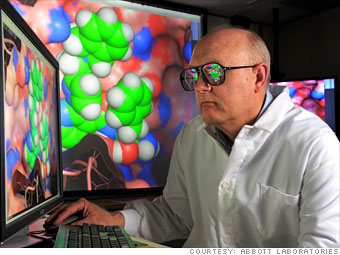
Company: Abbott Laboratories
Employee: Charlie Hutchins
Job: Senior principal scientist, Molecular Modeling
For 23 years, Charlie Hutchins' job at Abbott Laboratories has been to take molecules and proteins invisible to the naked eye and turn them into large, 3-D images. This process is crucial for scientists solving problems in the lab, he says: "If a 2-D picture is worth a thousand words, a 3-D picture must be worth a million words."
Three-dimensional imaging has paid off for drug development at Abbott. In fact, Hutchins' molecular imaging department was key in the development of one of the company's HIV/AIDS drugs. Abbott released the first version of the drug, called Norvir, in 1996, but the virus grew resistant to the drug over time. So Hutchins and other scientists went back to the drawing board.
Through molecular imaging, they figured out how to change the structure of Norvir in a way that prevented the virus from becoming developing resistance. Abbott released the new version, called Kaletra, in 2000. It is one of the leading drugs for the treatment of HIV/AIDS.
To see small structures, Hutchins and other specialists use imaging programs that render molecules and then project them on a 6-by-8-foot screen. To view them in 3-D, Hutchins says, "I wear a set of glasses that kind of makes me look like a Blues Brother.
Employee: Charlie Hutchins
Job: Senior principal scientist, Molecular Modeling
For 23 years, Charlie Hutchins' job at Abbott Laboratories has been to take molecules and proteins invisible to the naked eye and turn them into large, 3-D images. This process is crucial for scientists solving problems in the lab, he says: "If a 2-D picture is worth a thousand words, a 3-D picture must be worth a million words."
Three-dimensional imaging has paid off for drug development at Abbott. In fact, Hutchins' molecular imaging department was key in the development of one of the company's HIV/AIDS drugs. Abbott released the first version of the drug, called Norvir, in 1996, but the virus grew resistant to the drug over time. So Hutchins and other scientists went back to the drawing board.
Through molecular imaging, they figured out how to change the structure of Norvir in a way that prevented the virus from becoming developing resistance. Abbott released the new version, called Kaletra, in 2000. It is one of the leading drugs for the treatment of HIV/AIDS.
To see small structures, Hutchins and other specialists use imaging programs that render molecules and then project them on a 6-by-8-foot screen. To view them in 3-D, Hutchins says, "I wear a set of glasses that kind of makes me look like a Blues Brother.
When you blow something up to a big screen, you can see a different dimension of the problem. Going from the teeny tiny to the big does show you stuff."
More galleries
Last updated May 18 2011: 8:41 AM ET
